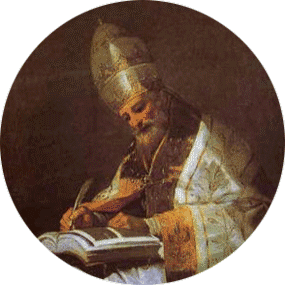
10 November
St. Leo the Great (400-461)
Pope and Doctor of the Church
Born: 400 at Tuscany, Italy
Died: 11 April 461 at Rome, Italy
Today the Church celebrates the memorial of St. Leo the Great, pope and doctor, during whose pontificate the Council of Chalcedon (451) defined that Christ is one divine person with two natures, divine and human. It was a confirmation of his Epistola Dogmatica (Tomus) to the Patriarch Flavian of Constantinople. He vigorously defended the unity of the Church. He detained the onrush of the barbarians under Attila. His feast day in the Extraordinary Rite is April 11.
COLLECT PRAYER
O God, who never allow the gates of hell to prevail against your Church, firmly founded on the apostolic rock, grant her, we pray, that through the intercession of Pope Saint Leo, she may stand firm in your truth and know the protection of lasting peace. Through our Lord Jesus Christ, your Son, who lives and reigns with you in the unity of the Holy Spirit, God, for ever and ever.
Things to Do:
- Learn more about the Nestorian heresy and the Council of Chalcedon;
- Just as St. Leo triumphed over the pagan invaders, pray for the civilized barbarians who would persuade us that religion should be eliminated from education and that the State, in its laws and institutions should simply ignore our Lord Jesus Christ;
- Read Pope John XXIII’s Encyclical on St. Leo;
- The name Leo means “lion,” so a cake in the shape of a lion would be an appropriate name-day dessert.
Source: Catholic Culture
November 10th is the memorial of St.Pope Leo the Great, who was a proficient writer, composing 143 letters and over 96 sermons which add insight into the ecclesiastical practices of the time as well as speak in clear theological language.
He was involvement in the fourth ecumenical council helped prevent the spread of error on Christ’s divine and human natures.St. Leo intervened for the safety of the Church in the West as well, persuading Attila the Hun to turn back from Rome.Eastern Catholics and Eastern Orthodox Christians also maintain a devotion to the memory of Pope St. Leo the Great. Churches of the Byzantine tradition celebrate his feast day on Feb. 18.
“As the nickname soon attributed to him by tradition suggests,” Pope Benedict XVI said in a 2008 general audience on the saint, “he was truly one of the greatest pontiffs to have honoured the Roman See and made a very important contribution to strengthening its authority and prestige.”
Leo’s origins are obscure and his date of birth unknown. His ancestors are said to have come from Tuscany, though the future pope may have been born in that region or in Rome itself. He became a deacon in Rome in approximately 430, during the pontificate of Pope Celestine I.
During this time, central authority was beginning to decline in the Western portion of the Roman Empire. At some point between 432 and 440, during the reign of Pope St. Celestine’s successor Pope Sixtus III, the Roman Emperor Valentinian III commissioned Leo to travel to the region of Gaul and settle a dispute between military and civil officials.
Pope Sixtus III died in 440 and, like his predecessor Celestine, was canonized as a saint. Leo, away on his diplomatic mission at the time of the Pope’s death, was chosen to be the next Bishop of Rome. Reigning for over two decades, he sought to preserve the unity of the Church in its profession of faith, and to ensure the safety of his people against frequent barbarian invasions.
Leo used his authority, in both doctrinal and disciplinary matters, against a number of heresies troubling the Western church – including Pelagianism (involving the denial of Original Sin) and Manichaeanism (a gnostic system that saw matter as evil). In this same period, many Eastern Christians had begun arguing about the relationship between Jesus’ humanity and divinity.
As early as 445, Leo had intervened in this dispute in the East, which threatened to split the churches of Alexandria and Constantinople. Its eventual resolution was, in fact, rejected in some quarters – leading to the present-day split between Eastern Orthodoxy and the so-called “non-Chalcedonian churches” which accept only three ecumenical councils.
As the fifth-century Christological controversy continued, the Pope urged the gathering of an ecumenical council to resolve the matter. At the Council of Chalcedon in 451, the Pope’s teaching was received as authoritative by the Eastern bishops, who proclaimed: “Peter has spoken through the mouth of Leo.”
Leo’s teaching confirmed that Christ’s eternal divine personhood and nature did not absorb or negate the human nature that he assumed in time through the Incarnation. Instead, “the proper character of both natures was maintained and came together in a single person.”
“So without leaving his Father’s glory behind, the Son of God comes down from his heavenly throne and enters the depths of our world,” the Pope taught. “Whilst remaining pre-existent, he begins to exist in time. The Lord of the universe veiled his measureless majesty and took on a servant’s form. The God who knew no suffering did not despise becoming a suffering man, and, deathless as he is, to be subject to the laws of death.”
In 452, one year after the Council of Chalcedon, Pope Leo led a delegation which successfully negotiated with the barbarian king Attila to prevent an invasion of Rome. When the Vandal leader Genseric occupied Rome in 455, the Pope confronted him, unarmed, and obtained a guarantee of safety for many of the city’s inhabitants and the churches to which they had fled.
Pope St. Leo the Great died on Nov. 10, 461. He was proclaimed a Doctor of the Church by Pope Benedict XIV in 1754. A large collection of his writings and sermons survives, and can be read in translation today.
Source: Catholic News Agency (CNA)